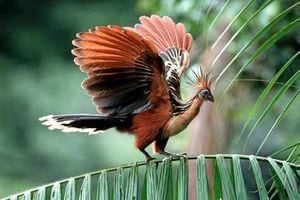Hoping for harpies
Our wildlife explorer Tim Earl looks forward to returning to Guyana, where the group he takes out will hopefully see several of the most exotic bird and animal species on Earth...

Our wildlife explorer Tim Earl looks forward to returning to Guyana, where the group he takes out will hopefully see several of the most exotic bird and animal species on Earth...
MY FIRST experience of hammock sleeping was when staying at an Amerindian village deep in the rainforest of Guyana.
The secret is to lie corner to corner, diagonally across the hammock and, with a mosquito net thrown over the top, a reasonably safe night's sleep can be expected.
Guyana is my favourite South American country and after a break of several years, I am returning in 2015.
With a new itinerary that includes two stays with local Amerindian communities – Surama on the Burro Burro River and Rewa high up the Rupununi River – the tour looks to be better than ever.
Deep in jungle, Surama was where I slept in a hammock for three nights. Rewa is even more remote and only a few hundred people have ever visited the village.
It is a three-hour boat trip up the Rupununi, equidistant between Surinam to the east and Brazil to the west and south.
The surrounding area is rainforest, mountains and oxbow lakes, teeming with wildlife.
Rewa's community of approximately 220 is predominately Macushi, with a few families of the Wapashani and Patamona tribes.
Villagers practice subsistence farming, fishing and hunting, with little opportunity for cash employment.
The community constructed the Rewa Eco-lodge in 2005 so that they could establish a sustainable eco-tourism business.
It remains virtually unknown, with only a few hundred visitors to date.
The wildlife will be exceptional.
Harpy eagle, a vast bird which feeds on monkeys snatched from branches high in the canopy, will be our primary 'hoped-for' but there will be much more besides.
Cock-of-the-rock is one of the most extraordinary birds in the world.
The males are bright orange and live in dense, dark rainforest. They gather at special dance floors to display communally, watched by females who select the brightest as their mate. He really does become cock of the rock.
Guyana has become one of the hottest destinations to see this exotic species.
Standing on the southern bank high above the river is the pristine forest in which cocks of the rock congregate.
Walking quietly into the area, it takes a moment or two for eyes to become accustomed to the gloom and then suddenly, there they are. Two males like great orange beacons in the darkness.
Unless you can find an active lek (as the dance-floor is called) there is little more to them. The birds just sit there having their pictures taken until they get bored and, like supermodels, they disappear into the forest.
Arrowpoint Nature Resort is where the wilderness part of the tour will start. It is a one-hour canoe trip up a narrow stream which runs into the Essequibo River.
A fabulous place, it hosts another amazingly coloured bird, a hummingbird – the crimson topaz. Just the name is exotic, but imagine going out to look for them.
We will rise in the dark, climb into kayaks and then paddle upstream quietly as dawn breaks.
Light and then sunshine comes quickly in the tropics and as the sun rises, we enter a section of narrow stream.
The brilliantly-coloured birds hover and dart after the insects, deep in the shade created by lianas which cross the stream.
What satisfaction there is in paddling one's own canoe in life, making great discoveries (albeit already made by others) and learning from experience.
After two hours of blissful, peaceful birding we will return to camp and a much-anticipated breakfast.
The Iwokrama Field Station is also remote, 200 miles inland, a flight, overland travel by 4x4 vehicles and yet more dug-outs.
It is a research centre which has geared up to cater for tourists. The surrounding forests hold a good population of jaguars and exotic forest birds.
These include the cotingas, a group of which cock of the rock is a member.
We saw no fewer than 10 members of the group on my last trip and in doing so came across many other great species.
Some of the time we were birding from a magnificent canopy walkway deep in jungle.
We slept in a camp, Attara Rainforest Lodge, at its base, rising just before daybreak to experience birdlife at treetop level.
Flocks of tanagers passed, feeding and chattering at the same time, hummingbirds with names like long-billed starthroat, black-eared fairy and rufous-throated sapphire zipped past, and the greatest prize, several waved woodpeckers, were recorded in a short while.
Moving ever deeper into Guyana's hinterland, we will eventually arrive at an idyllic spot, home to a tall, elegant elderly woman whose mission in life has been to rescue giant river otters.
Karanambu is a collection of comfortable thatched cottages which together are the home of Diane McTurk, who has been instrumental in saving the six-foot-long otters and in doing so promoting Guyana.
It is hard to imagine a more peaceful spot, miles from anywhere, surrounded by gallery forest, marshes and stretches of river. Here we could see Guyana's national bird, the prehistoric-looking hoatzin.
Arriving by canoe, one is greeted by a giant river otter which dives under the boat and whistles with delight.
Meals are with Diane and her family, with talk of surviving in the jungle, communication with the outside world and the problems of catering for groups bigger than 10 people.
We sleep two to a cottage with bats zooming through the rooms at night.
An evening boat trip takes us under colonies of boat-billed herons and a rufescent tiger-heron may be spotted if we are lucky.
Nightjars are common (we should see band-tailed and least nighthawks) and there is a good selection of ant-birds.
These are members of a fascinating but difficult group of birds which follow ant swarms across the jungle floor.
The ants are voracious, killing and eating any living creature in their paths. As a result, no insect is safe and they break out of their camouflaged cover to flee the ants, thus becoming visible to the birds.
Up to 40 species can be found in the vicinity of the ant swarms and it is every jungle birder's aim to locate one.
Karanambu will be a glorious end to our Guyanese adventure.





